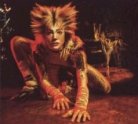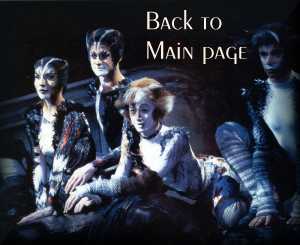One of the greatest challenges a dancer can have is to in his/her dance give the illusion of an animal, much more gracious than the human, and even so the movement and acrobatic in a cat. But Andrew Lloyd Webber tried and succeeded in reaching just that effect in his dancers. With the help of choreographers, scenographers, light and sound technicians, musicians and artist, that sings, dances and acts, he created the musical Cats that was put up in London for the
first time in 1981 and still is playing on about fifty places around the world, it is now the longest running musical. Of course it wasn't an easy job but who wouldn't have succeeded if not him, who also had made Jesus Christ Superstar (1970), Evita (1975) and many other successful musicals.
In most of Webbers productions has the lyrics been made to fit his music, but in not in Cats- as far as possible Webber kept Eliots lyrics in Old Possum's Book of Practical Cats unchanged and wrote the music to the lyrics. He had a great help of the fact, that already the original poems is extraordinary musical, so that the poems own rhythm inspired him when he composed the music.
One thing the musical did so well- to get the artist to stop being humans and become cats.
Maybe the dance is one of art forms that fits best in gestalt the cat. Isn't it the cats' movement that is characteristic for it? And it was just that which was asked of the dancers in Cats: to that in everything act like a cat, be reserved like them and at the same time sensual, warm, cold, it self enough, gracious and mystical like only cats can be, and to get out all that in a speeding crescendo that swipes the audience into just that atmosphere that IS Eliots poems, a now disappeared London in the thirties.The audience is being brought into the cats' world, living with them in their destinys and adventures, laughing, loving and suffering with the nowadays-famous Jennyanydots (the effective cat), Growltiger (the pirate cat), Old Deuteronomy (the wise old cat), Mungojerrie and Rumpleteaser (the horrible troublemakers), Macavity (the mystery cat) and all the others. It's a world of dark alleys, the docks of the Thames, the citys roofs and buildings, but most of all the street, the junkyard; wich is the cats' real theatre-stage. The musical reaches its top when the one time so loveable Grizabella, who is now disliked, sings out her pain.
The lyric to Memory wasn't taken with in Eliots book. He thought it to be too sad to be read for children. Grizabella is the socially outcaste cat, which lives on memories and is longing for contact, a place in the society, but everyone walks away from her- not wanting anything to do with her. In her misery nothing is left but to in the cold night call out to the cold moon and blaming it for forgetting the time when she was the glamorous cat-girl, unresistible, loved and admired by all.
But we get to se the cat people too, since the musicals cat-society mirrors the human society- but at the same time are they also just cat cats- the dancers moves and behaves like cats.
It's just that extraordinary experience that joins Eliots poems with the CATSensembles: to read the poems or to se the musical, two typical human behaviours, increases our understanding for the cats, since they both are able to show us a little of the cats unmystified inner nature and creates the feeling that the stages actors aren't men and women dressed up as cats but cats disguised to humans.

